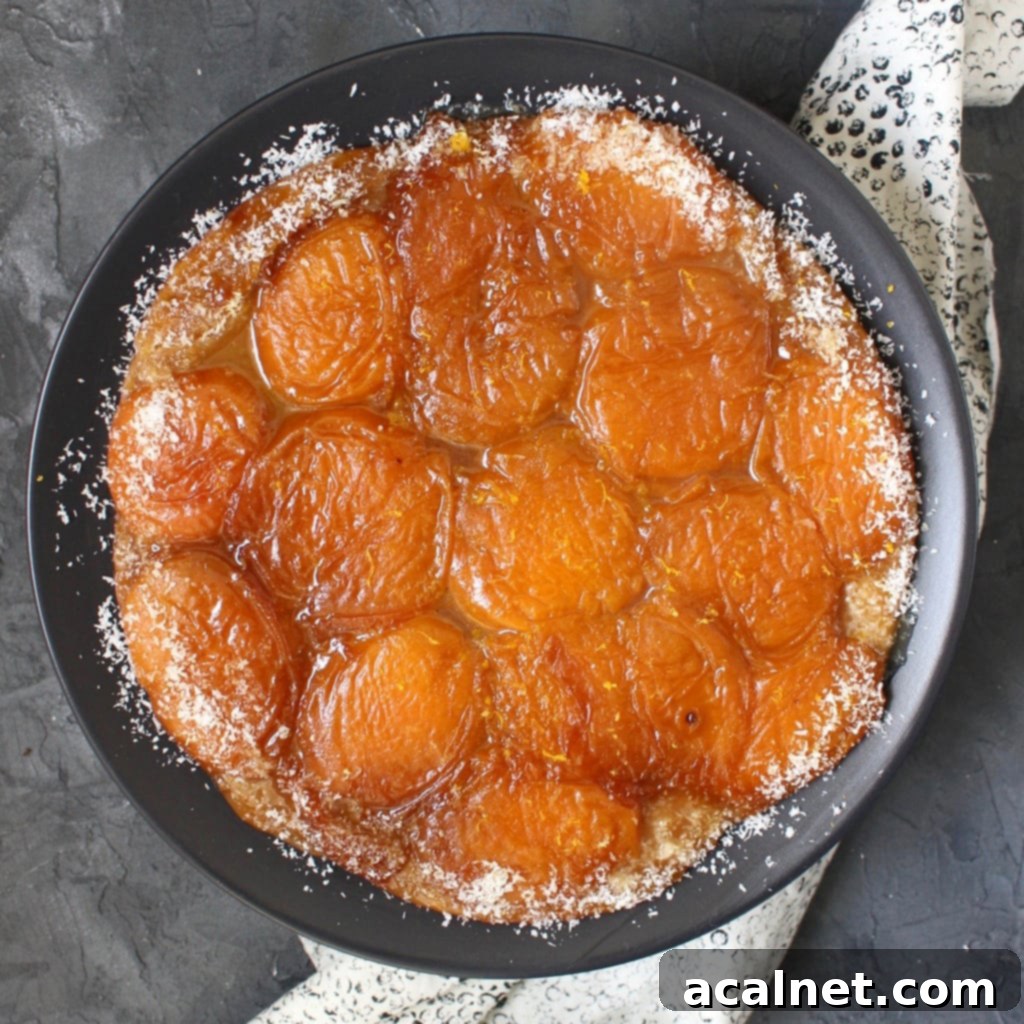Sweet & Tangy Apricot Tarte Tatin with Lemon Caramel: Your Ultimate French Summer Dessert
Oh, if only you could experience the irresistible aroma that fills my kitchen when this Apricot Tarte Tatin with Lemon Caramel bakes! It’s a scent that promises pure delight, a harmonious blend of sweet, bright, and buttery notes that signals something truly special is coming out of the oven. This magnificent Tarte Tatin perfectly balances the natural sweetness of ripe apricots with a zesty lemon-infused caramel, all encased in a golden, crisp, and utterly delicious pastry crust. Apricots, often underestimated in the vast world of baking, truly shine in this classic French dessert, proving they are a magnificent stone fruit for creating unforgettable, seasonal treats.
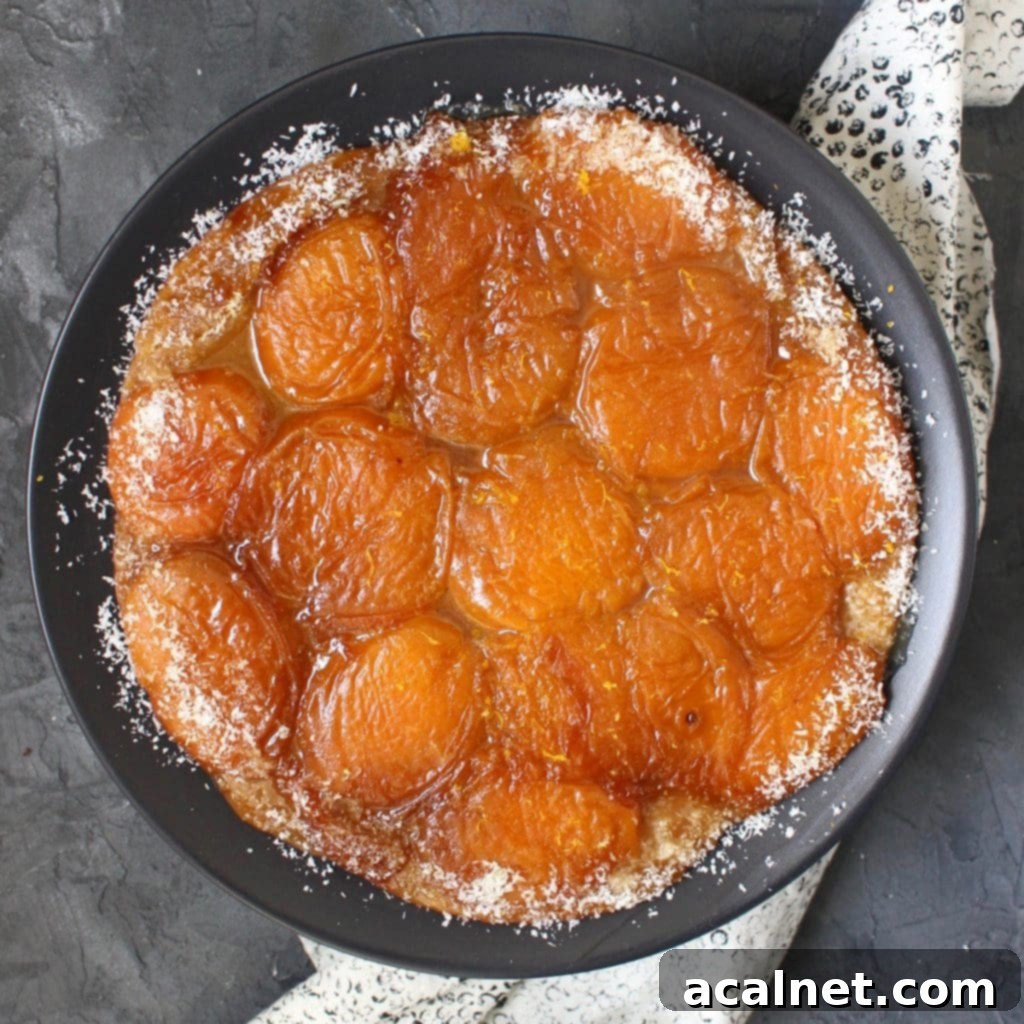
I simply adore apricot desserts, and it’s a genuine shame that these beautiful stone fruits are often overlooked in the world of baking. When given the chance, apricots transform into truly exceptional and deliciously complex treats. Much like my beloved Apricot Crumble, the vibrant fresh apricots of summer are the undisputed stars of this recipe. This Upside-Down Apricot Tart is not just a dessert; it’s a celebration of summer’s bounty, offering a delightful and creative way to utilize this seasonal fruit in a spectacular fashion.
What is a Tarte Tatin? A French Upside-Down Classic
The Tarte Tatin is a legendary French ‘upside-down’ tart, famous for its rustic charm and exquisite flavor profile. The easiest way to describe a Classic French Tarte Tatin is to simply say that it is an Upside-Down Tart. Originating from the Hotel Tatin in Lamotte-Beuvron, France, the story goes that one of the Tatin sisters, Stéphanie, accidentally baked an apple tart upside down, rushing to serve her guests. Her ‘mistake’ turned into a culinary masterpiece, becoming a beloved dessert worldwide.
Like an upside-down cake, a Tarte Tatin consists of two main elements: a rich, buttery pastry (in our case, a Pâte Brisée) and a luscious, caramelized topping, typically made from fruit. The magic of this dessert lies in its dramatic reveal; the fruit is caramelized in butter and sugar at the bottom of a pan, then covered with a layer of pastry before baking. Once baked to golden perfection, the tart is deftly inverted onto a serving plate, unveiling a glistening, caramel-coated fruit topping that’s utterly irresistible.
The beauty of a Tarte Tatin truly lies in its incredible versatility. While apples are the traditional choice, you can pretty much use any fruit you’d like. Imagine the juicy sweetness of a Pear Tarte Tatin or the tender delight of a Peach Tarte Tatin. But this tart doesn’t have to be exclusively sweet; you can also create savory versions with a non-sweetened tart pastry and fresh vegetables like tomatoes, onions, or even root vegetables for a delightful twist. To make any Tarte Tatin, you simply need to embrace the upside-down philosophy: caramelize your chosen ingredients at the bottom of a pan, cover with pastry, bake, and then flip to reveal your delicious creation!
Homemade Pâte Brisée: The Perfect French Pastry Base
For this divine Apricot Tarte Tatin, we’re crafting my go-to Pâte Brisée. “Pâte what!?” you might ask. While I could simply call it a Shortcrust Pastry, the French term Pâte Brisée is hard to translate exactly into English without losing some nuance. If you appreciate the art of French Pastry, you’ll know there are a few distinct types of pastries commonly used for tarts: Pâte Sucrée (sweet pastry), Pâte Brisée (broken pastry), Pâte Feuilletée (puff pastry), and Pâte Sablée (sandy pastry).
Unfortunately, apart from Pâte Feuilletée (Puff Pastry), there isn’t an exact English translation for the others. They often get lumped together under the umbrella term “Shortcrust Pastry,” despite their subtle but important differences. So, what makes a Pâte Brisée truly distinctive? Unlike a Pâte Sucrée or a Pâte Sablée, which typically incorporate very soft or creamed butter into the dry ingredients for a crumbly texture, a Pâte Brisée requires cold butter. The cold butter is cut into the flour, creating small pockets that, when baked, contribute to a wonderfully tender and slightly flaky texture.
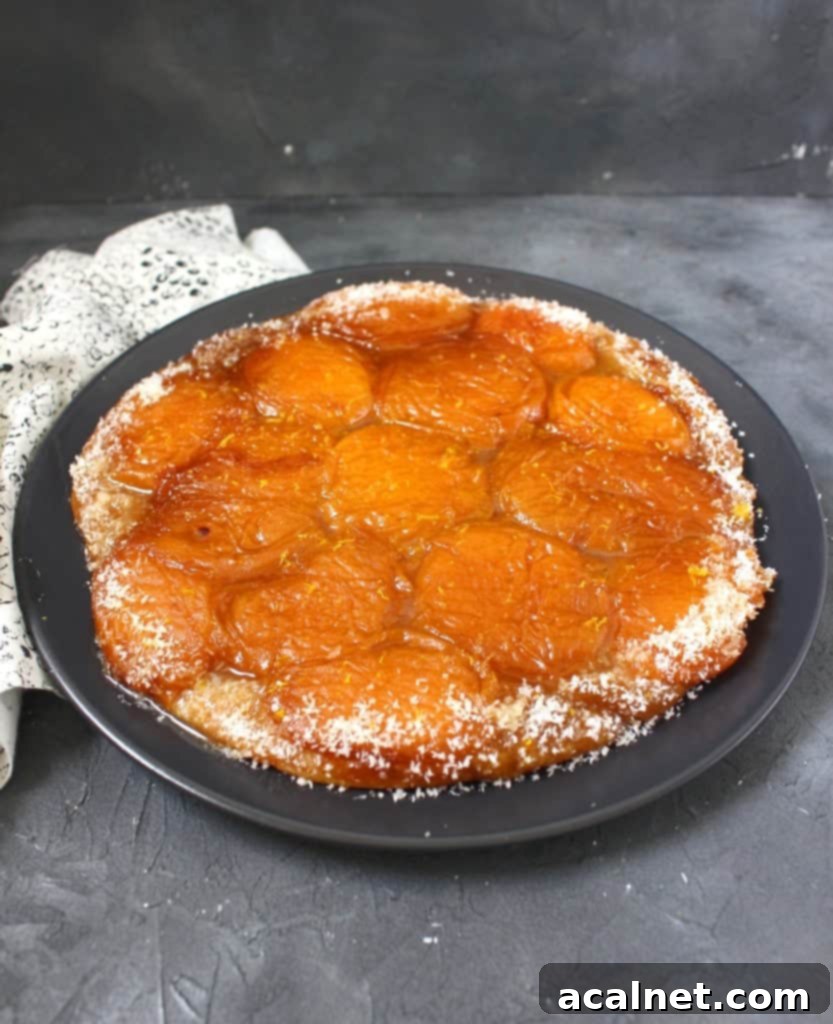
The key to success with Pâte Brisée is to work the pastry quickly – and always use cold ingredients – to ensure the butter doesn’t start melting prematurely. This method prevents the gluten from overdeveloping, resulting in a perfectly tender, not tough, crust. Out of all the different French Pastries, the Pâte Brisée is considered the most basic and, happily, the easiest one to master, making it ideal for home bakers! You only need four fundamental ingredients:
- Flour
- Sugar (a touch for slight sweetness, but also good for savory tarts without it)
- Cold Butter
- Ice Water
Follow the golden ratio of roughly two parts flour to one part butter to ensure a consistently successful Pâte Brisée every single time. Once all the ingredients have been combined (you’ll find detailed steps in the recipe card below), the pastry absolutely needs to be chilled. Skipping this crucial step or baking it when the butter is still too warm will cause the pastry to shrink dramatically in the oven. What I particularly love about this recipe is that it can be effortlessly prepared in a food processor, simplifying the process and making it even more accessible! This versatile pastry is a fantastic foundation for many dishes, both sweet and savory. Check out other delicious recipes I’ve made using a version of this adaptable pastry:
- Feta Asparagus Quiche
- Chocolate Cherry Tart
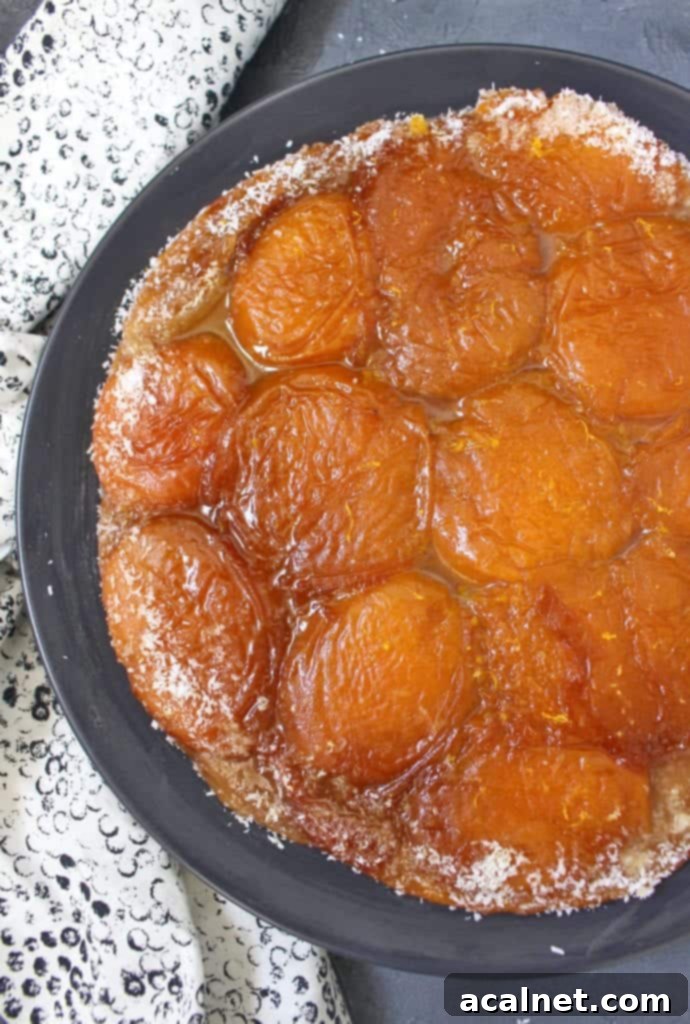
How to Make a Bright & Tangy Lemon Caramel
Now that we’ve covered the crucial pastry element of this Apricot Tarte Tatin, let’s turn our attention to the star topping: the luscious caramel. The second, equally important, element of this recipe involves beautifully caramelized fruits. In this particular dessert, we’re using those delicious fresh apricots, gently cooked and infused with a vibrant Lemon Caramel. There are many ways to make a caramel – often prepared in a pot and frequently enriched with cream – but for our Tarte Tatin, the caramel is ingeniously made directly in the pan, simplifying the process without compromising on flavor.
Crafting this caramel is far from complicated; it involves just a few simple ingredients mixed together and heated gently until they transform into a golden, bubbling delight:
- Butter
- Brown Sugar
- Fresh Lemon Juice
- Water
The strategic addition of lemon juice is a brilliant way to cut through the inherent sweetness of a traditional caramel, creating a far more interesting and balanced flavor profile. This citrusy twist adds a bright, tangy counterpoint that elevates the entire dessert. As a self-proclaimed lover of all things tangy and citrusy, incorporating lemon into this recipe was an absolute no-brainer for me. If your palate prefers a supremely sweet caramel, you can certainly make this recipe without the lemon. However, I wholeheartedly recommend experiencing this version of a Lemon Caramel; it is truly the element that makes this particular Apricot Tarte Tatin utterly distinctive and unforgettable, harmonizing perfectly with the natural tartness of the apricots.
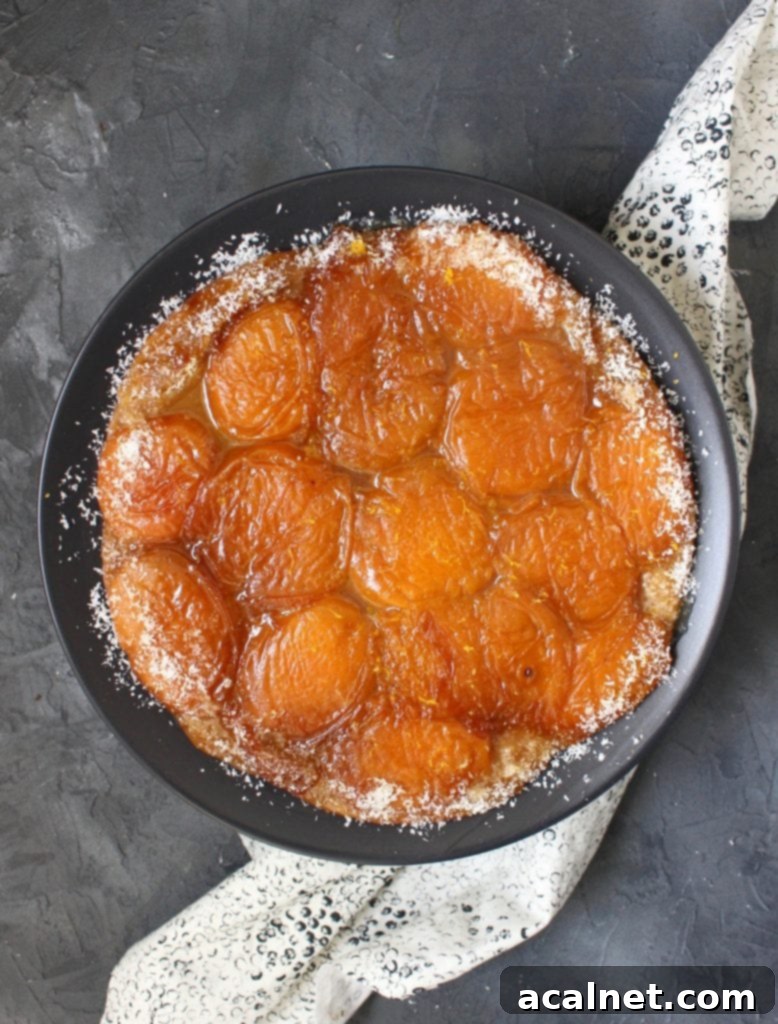
Assembling Your Apricot Tarte Tatin: The Grand Finale
Alright, you’ve mastered the Pâte Brisée, which is now happily chilling in the fridge, and your gorgeous apricots are caramelizing beautifully in their lemon-infused bath. What’s next? The exciting part: assembling your show-stopping Apricot Tarte Tatin! For this recipe, I highly recommend using a Springform Pan or a tart pan with a removable bottom plate. Lining it with baking paper is an absolute must, as it will make the crucial, yet potentially tricky, step of flipping the tart significantly easier. The caramel continues to cook and thicken in the oven, and it can become quite sticky, adhering to the edges of a standard pan.
Carefully arrange your beautifully caramelized apricot halves on the bottom of your prepared pan. Ensure the vibrant, sliced side of each apricot is facing upwards – this creates a stunning visual display when the tart is inverted. Drizzle any remaining Lemon Caramel from your cooking pan over the apricots, ensuring every crevice is filled with that golden, tangy sweetness. It’s important to allow the fruit and caramel mixture to cool down slightly before proceeding. Placing cold pastry directly over a very hot filling can cause the butter in your Pâte Brisée to melt prematurely, which can compromise its texture. Lastly, retrieve your chilled Pâte Brisée from the fridge and roll it out into a rough circle, slightly larger than your pan. Don’t strive for absolute perfection; the rustic charm is part of the Tarte Tatin’s appeal!
Gently drape the pastry over the apricots and caramel, tucking the edges down around the fruit to create a neat seal. Before placing it in the oven, make a small incision or hole in the center of the pastry. This tiny vent allows steam to escape during baking, preventing the crust from puffing up excessively and ensuring it bakes evenly to a glorious golden brown. And that’s it! Your exquisite Apricot Tarte Tatin with Lemon Caramel is now perfectly assembled and ready for the oven, promising a bubbly, fragrant, and utterly delicious outcome.
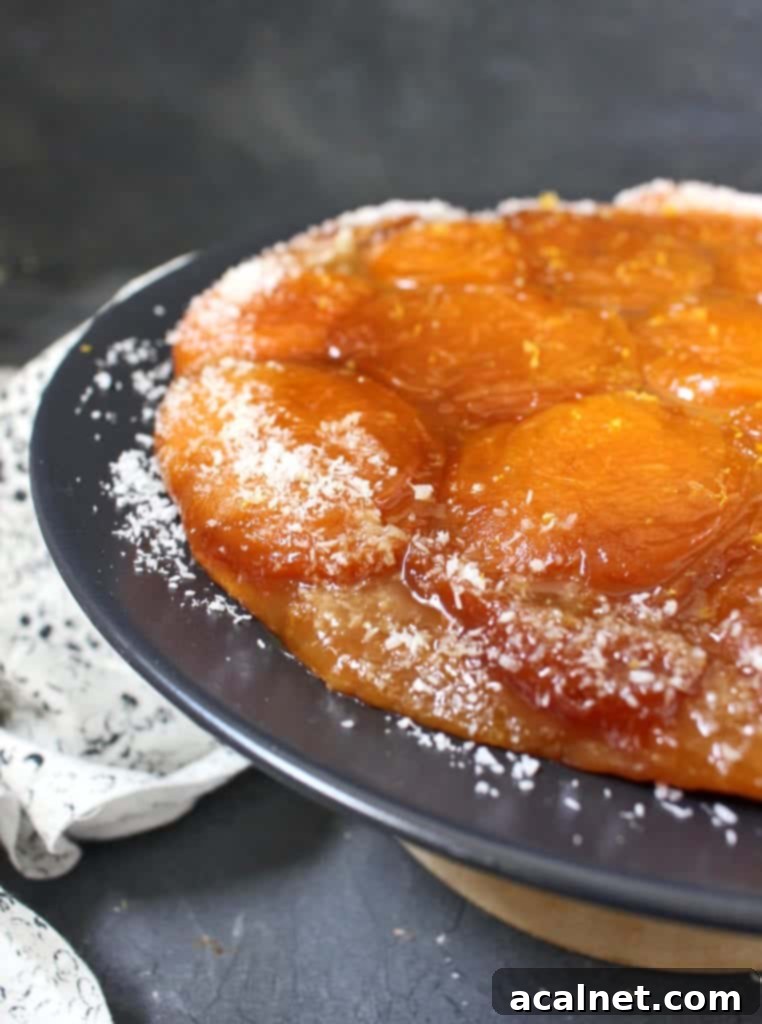
Embrace the Upside-Down Trend: Other Delicious Inspirations
If you’ve fallen in love with the clever concept of upside-down desserts, there’s a whole world of culinary delights to explore beyond our Apricot Tarte Tatin. This technique, where the “topping” becomes the “bottom” and then flips to reveal a stunning presentation, works beautifully with a variety of fruits and flavors. Get inspired by these other fantastic upside-down recipes:
- Red Wine Pear Tarte Tatin: A sophisticated twist with pears poached in red wine.
- Upside-Down Blackberry Cake: Juicy blackberries burst through a tender cake.
- Persimmon Upside-Down Cake: Sweet, mild persimmons create a unique flavor.
- Caramelised Apple Upside Down Cake: The classic for a reason, comforting and delicious.
- Plum Upside Down Cake: Tangy plums beautifully complement a moist cake base.
Made this recipe?
Let us know if you liked it by leaving a comment below, and tag us on Instagram @a.baking.journey with a photo of your creation!
Recipe: Apricot Tarte Tatin with Lemon Caramel
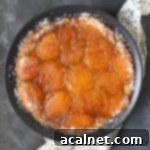
Apricot Tarte Tatin with Lemon Caramel
Print Recipe
Ingredients
Pate Brisee
- 1 cup (160 gr) Plain Flour
- 1 tbsp Brown Sugar
- 3 oz (80gr) Cold Butter
- 1/4 cup (60ml) Cold Water
- 1/4 teasp. Cinnamon Powder, Optional
Apricots and Lemon Caramel
- 7 Small Apricots
- 3.5 oz (100gr) Butter
- 1/3 cup (60gr) Brown Sugar
- 1/4 cup (60ml) Lemon Juice
- 1/4 cup (60ml) Water
Instructions
Pate Brisee
- Put the Flour, Brown Sugar and Cinnamon Powder (if using) into the bowl of your food processor and pulse a couple of times to mix the dry ingredients together. (See note 1 if you don’t have a food processor).
- Add in the Cold Butter, cut into small cubes. Pulse to mix the butter with the dry ingredients until you get a sandy / crumbly texture. Try not to over-mix it; you don’t want the butter pieces to be too small or start melting.
- Add in the Cold water and mix one more time until the dough just begins to come together.
- Transfer the Pate Brisee pastry onto your kitchen bench dusted with a little bit of flour. Roughly gather the dough into a ball, cover with cling wrap, and gently press on it to flatten it into a disc. Place in the fridge to rest for at least 30 minutes.
Apricots and Lemon Caramel
- Wash your Apricots and slice them in half, removing the pit.
- In a large, oven-safe pan (or a pan you’ll use to transfer the caramel/fruit), melt your Butter and Brown Sugar. Then, add the Lemon Juice and Water. Add the Apricot halves to the caramel mixture, cut-side down, and cook for 20 to 30 minutes on low heat, gently flipping them a few times to achieve a beautiful caramelization on both sides.
To assemble the Apricot Tarte Tatin with Lemon Caramel
- Preheat your oven to 180°C (350°F).
- Line a round springform pan or tart pan with baking paper. Arrange the caramelized Apricots on the bottom of the pan, keeping them as tight as possible. The cut side should be facing up for a beautiful presentation.
Cover the Apricots with the remaining Lemon Caramel that should be left in your pan. Set aside to cool slightly.
- Roll your chilled Pate Brisee into a rough circle, slightly larger than your pan, and carefully cover the apricots with it. Press the edges of the pastry to fully cover and seal the apricots. Cut a small hole in the center of the pastry to allow for steam to come out while baking.
- Bake for 25 to 30 minutes, or until the Pate Brisee pastry is golden brown and fully cooked through.
Carefully remove from the oven (be mindful of potential hot caramel bubbling out from the bottom of the pan) and place on a cooling rack for about 15 minutes. This cooling time is crucial before attempting to flip the Tarte Tatin over. Serve warm.
- If you are not serving the Apricot Tarte Tatin straight away, you can place it back in the oven for 5 to 10 minutes to re-heat it gently. Alternatively, place it for a few minutes under the oven grill to enhance the caramelization of the tart before serving.
- Optional: for an extra touch of flavor and texture, sprinkle a little bit of desiccated coconut and fresh orange zest over the tart just before serving.
Would you like to save this recipe?
We’ll email this post to you, so you can come back to it later!
Notes
- If you are making this pastry without a food processor, sift the dry ingredients into a large bowl. Cut the cold butter into small cubes, then use a pastry cutter or two forks to blend the butter into the flour mixture until it resembles coarse crumbs. Gradually add the ice water and quickly bring the dough together into a ball with your hands, being careful not to overwork it.
This Apricot Tarte Tatin with Lemon Caramel is more than just a dessert; it’s an experience, a delightful journey through sweet, tangy, and buttery flavors that epitomize summer baking. Whether you’re serving it warm with a scoop of vanilla ice cream, a dollop of crème fraîche, or simply on its own, its rustic charm and exquisite taste are guaranteed to impress. Don’t let apricot season pass you by without trying this sensational French classic. Happy baking!
